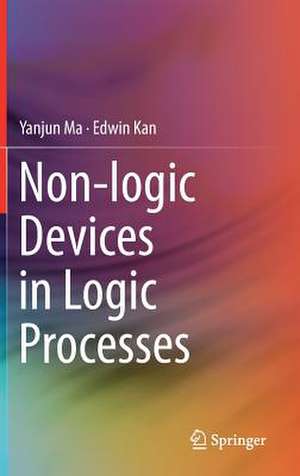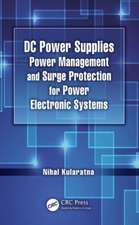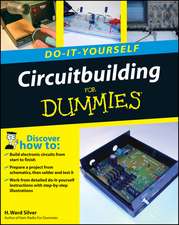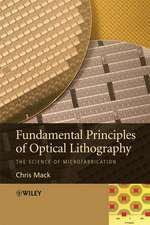Non-logic Devices in Logic Processes
Autor Yanjun Ma, Edwin Kanen Limba Engleză Hardback – 5 apr 2017
| Toate formatele și edițiile | Preț | Express |
|---|---|---|
| Paperback (1) | 945.14 lei 6-8 săpt. | |
| Springer International Publishing – 20 iul 2018 | 945.14 lei 6-8 săpt. | |
| Hardback (1) | 647.27 lei 6-8 săpt. | |
| Springer International Publishing – 5 apr 2017 | 647.27 lei 6-8 săpt. |
Preț: 647.27 lei
Preț vechi: 761.49 lei
-15% Nou
Puncte Express: 971
Preț estimativ în valută:
123.89€ • 134.62$ • 104.14£
123.89€ • 134.62$ • 104.14£
Carte tipărită la comandă
Livrare economică 21 aprilie-05 mai
Preluare comenzi: 021 569.72.76
Specificații
ISBN-13: 9783319483375
ISBN-10: 3319483374
Pagini: 318
Ilustrații: XXII, 284 p. 184 illus., 111 illus. in color.
Dimensiuni: 155 x 235 x 19 mm
Greutate: 0.61 kg
Ediția:1st ed. 2017
Editura: Springer International Publishing
Colecția Springer
Locul publicării:Cham, Switzerland
ISBN-10: 3319483374
Pagini: 318
Ilustrații: XXII, 284 p. 184 illus., 111 illus. in color.
Dimensiuni: 155 x 235 x 19 mm
Greutate: 0.61 kg
Ediția:1st ed. 2017
Editura: Springer International Publishing
Colecția Springer
Locul publicării:Cham, Switzerland
Cuprins
Part 1. Basics.- 1. Introduction.- 2. Overview of Logic CMOS Devices.- 3. Overview of Logic CMOS Process.- Part 2. Non-Logic Device Design in Logic Processes.- 4. Non-logic MOSFETs in Logic CMOS Process.- 5. Floating Gate Devices in Logic CMOS Process.- 6. Bipolar Transistors in Logic CMOS Process.- 7. Diodes in Logic CMOS Process.- 8. Logic Nonvolatile Memory.- 9. One Time Programmable Memories in Logic Process.- 10. Multiple Times Programmable Logic Nonvolatile Memory.- 11. Non-Data Storage Applications.- 12. CMOS Biosensors.- 13. Waveform Shaping Structures and Transmission Lines on CMOS.- 14. Conclusions and Outlook.
Notă biografică
Yanjun Ma is currently a Director of Portfolio Management and Principal Hardware Architect at the Invention Development Fund at Intellectual Ventures in Bellevue, WA. Prior to his current positions, Yanjun was a principal engineer and a director of Technology Development and Production Engineering at Impinj, Inc. in Seattle, Washington. He also had held senior research and engineering positions at Lattice Semiconductors, Sharp Labs of America as well as research positions at AT&T Bell Labs, Brookhaven National Lab, and the University of Washington.
He started his research career studying high temperature superconductors, quasicrystals, and x-ray physics which led to the discovery of a momentum conservation law in x-ray fluorescence. His more recent interests include semiconductor process and device physics, non-volatile memories, RFID, and low power computing architecture.Yanjun has over 80 publications in such journals as IEEE Electron Device Letter, Trans. On ElectronDevices, Applied Physics Letter, and Physical Review Letter. He also has over 35 issued US patents and a number of international patents and patent applications, with some very highly cited patents, including a few of the earliest patents on high k gate dielectrics.
Edwin C. Kan is a Professor at the School of Electrical and Computer Engineering, Cornell University, Ithaca, NY. Before joining Cornell, he had worked at Dawn Technologies as a Principal CAD Engineer and Stanford University as a Research Associate.
His main research areas include CMOS technologies, semiconductor device physics, flash memory, CMOS biosensors, RFID, RF indoor locating and tracking, and numerical methods for PDE and ODE.
He has over 80 journal publications,160 conference papers and three book chapters. He received the Presidential Early Career Award for Scientists and Engineer (PECASE) in October 2000 from the White House. He also received several teachingawards from Cornell Engineering College for his CMOS and MEMS courses.
He started his research career studying high temperature superconductors, quasicrystals, and x-ray physics which led to the discovery of a momentum conservation law in x-ray fluorescence. His more recent interests include semiconductor process and device physics, non-volatile memories, RFID, and low power computing architecture.Yanjun has over 80 publications in such journals as IEEE Electron Device Letter, Trans. On ElectronDevices, Applied Physics Letter, and Physical Review Letter. He also has over 35 issued US patents and a number of international patents and patent applications, with some very highly cited patents, including a few of the earliest patents on high k gate dielectrics.
Edwin C. Kan is a Professor at the School of Electrical and Computer Engineering, Cornell University, Ithaca, NY. Before joining Cornell, he had worked at Dawn Technologies as a Principal CAD Engineer and Stanford University as a Research Associate.
His main research areas include CMOS technologies, semiconductor device physics, flash memory, CMOS biosensors, RFID, RF indoor locating and tracking, and numerical methods for PDE and ODE.
He has over 80 journal publications,160 conference papers and three book chapters. He received the Presidential Early Career Award for Scientists and Engineer (PECASE) in October 2000 from the White House. He also received several teachingawards from Cornell Engineering College for his CMOS and MEMS courses.
Textul de pe ultima copertă
This book shows readers how to design semiconductor devices using the most common and lowest cost logic CMOS processes. Readers will benefit from the author’s extensive, industrial experience and the practical approach he describes for designing efficiently semiconductor devices that typically have to be implemented using specialized processes that are expensive, time-consuming, and low-yield. The author presents an integrated picture of semiconductor device physics and manufacturing techniques, as well as numerous practical examples of device designs that are tried and true.
Caracteristici
Enables readers to design less expensive integrated circuits, with higher yield, which reach the market faster Covers a wide range of topics, including device physics, device designs and implementation using the basic fab process, and practical circuit applications Includes many practical examples of device designs that have been proven in commercial products









